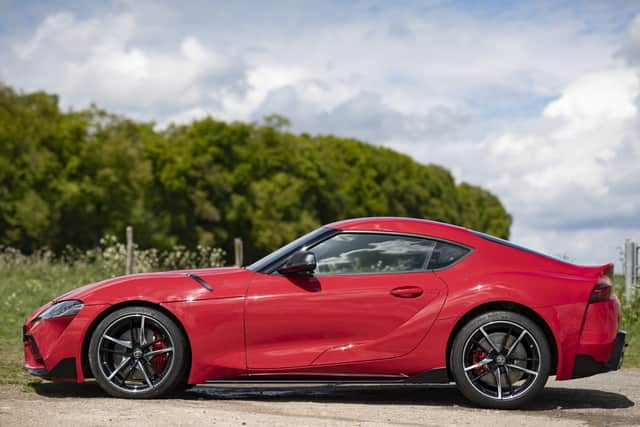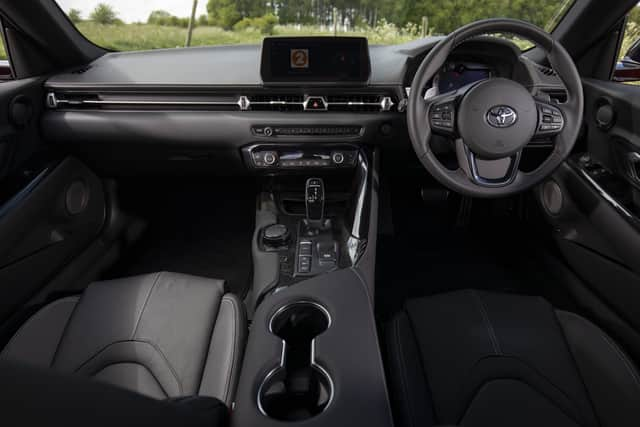2022 Toyota GR Supra review: price, specification and driving impressions of revived sports coupe
and live on Freeview channel 276
For car fans of a certain age, the Toyota Supra name is as important and evocative as Skyline, Impreza or NSX.
It has been around since the late 1970s but really captured the imagination of a generation in the mid-90s as tuner and gaming culture collided.
Advertisement
Hide AdAdvertisement
Hide AdSo when Toyota boss Akio Toyoda decided there would be “no more boring cars” it was an obvious name to revive, as a full-blown sports car alongside the cheaper GR86 coupe and rally-bred GR Yaris hatchback.
Budgets being what they are, however, it’s hard for one mainstream brand to justify the huge costs of creating an all-new sports car so, as is well documented, the GR Supra is the result of a collaboration between Toyota and BMW.


That means it shares platform, engine, transmission and most of its interior with the BMW Z4. Not that you’d know from the outside, where the Supra is very much its own car. While the Z4 is a regulation-looking Euro-cruiser with a folding hard-top, the Supra is a coupe with short overhangs and taut curves that look like they’ve been shrink-wrapped over the long bonnet and short rear haunches. There’s a double-bubble roof, headlights that recall the famous 1990s A80 and an elegant ducktail spoiler beneath which the name is picked out in the instantly recognisable 90s font.
Inside, it’s less eye-catching, lumbered with BMW’s sensible but restrained design, from the shades of grey and black on the surfaces right down to the 8.8-inch touchscreen. On the plus side, that means you get BMW’s iDrive instead of Toyota’s less-impressive system, as well as materials suited to the £50k+ price tag. There’s decent space for two, wrapped up in low-slung, grippy seats, and a surprisingly useable 290-litre boot beneath the rear hatch.
Advertisement
Hide AdAdvertisement
Hide AdWhile the basics are shared, the Supra’s chassis and engine setups are bespoke and designed to give the car its own character.
On the road, it feels hugely competent, composed and controlled. Almost a little too controlled. Its relatively compact size means it feels nimble and dives into corners with enthusiasm, aided by 50/50 weight balance and surprisingly supple adaptive suspension. There’s just the right weight and speed to the steering but not masses of feedback. On track you can provoke it into manageable tail-happy antics but on the road it feels utterly planted and perhaps a touch too sensible.


Nought to 62mph in 4.3 seconds doesn’t feel particularly sensible, though, and there’s a pleasing forcefulness and flexibility to the way the 335bhp 3.0-litre straight six punches the Supra along. It’s just a shame that even at full chat the bassy engine note is a little subdued.
There’s no doubt that this is a massively fast machine that will throw you back in your seat and carve up a sweeping rural A road with confidence but it feels less playful and engaging than the smaller, cheaper GR86 as well as more direct rivals like the Porsche Cayman.
Advertisement
Hide AdAdvertisement
Hide AdYou can step up the engagement levels by opting for a manual transmission. After initially saying there wouldn’t be one (because BMW hadn’t made one), Toyota bowed to pressure and sent its engineers off to transmission maker ZF with a shopping list and chequebook. Rather than an off-the-shelf unit, the Supra’s transmission is utterly bespoke and a lot of engineering has gone into this transmission, from reworking and strengthening the clutch to testing three different gearknobs to get just the right throw weight.
Pleasingly, the hard work has paid off and the manual unlocks another level of involvement. The shift is crisp, accurate and weighted perfectly, asking you to engage with the car in a way the auto simply doesn’t. Going for the manual also saves 40kg over the auto model, which can only aid agility, and brings a new-look centre console.
Both manual and automatic versions of the 3.0-litre Supra are available in standard or Pro trim and there is also a manual Pro Special Edition with unique matte white paint and tan leather upholstery. All versions get 19-inch forged alloys, adaptive suspension, active differential, an 8.8-inch touchscreen with Apple CarPlay, a 10-speaker sound system, Alcantara upholstery, cruise control, keyless entry and start and dual-zone climate control. The Pro version adds power adjustable heated seats with leather upholstery, a 12-speaker JBL audio package, head-up display and LED dual-beam headlights.
Like the cabin quality, it’s the sort of specification you’d expect from a sports car at this price but it’s secondary to the Supra’s real appeal, which is that of a purebred sports car. It’s perhaps not as lively as some rivals but its blend of muscular straight-six engine, agile, composed chassis and jaw-dropping looks have what it needs to stand out.
Toyota Supra 3.0 Pro
Advertisement
Hide AdAdvertisement
Hide AdPrice: £57,495 (£58,235 as tested); Engine: 3.0-litre, straight-six, twin-turbo, petrol; Power: 335bhp; Torque: 369lb ft; Transmission: Eight-speed automatic, rear-wheel-drive; Top speed: 155bhp; 0-62mph: 4.3 seconds; Economy: 34.4mpg; CO2 emissions: 188g/km
